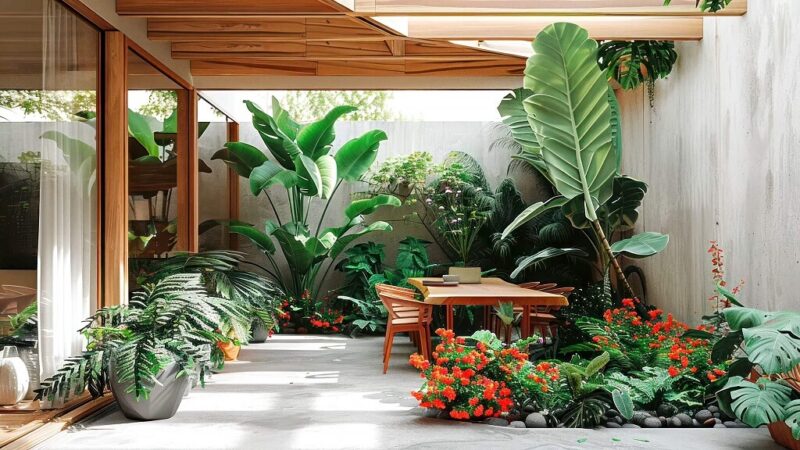Biophilic design transforms outdoor spaces like balconies and patios into calming extensions of the natural world. It goes beyond aesthetics, focusing on the essential connection we crave with nature. By using thoughtful design elements, you can turn your outdoor area into a peaceful retreat that promotes well-being and relaxation.
Imagine the gentle breeze flowing through lush greenery or the sunlight casting patterns across natural materials. These are not just pleasant touches but vital ways to uplift your mood and reduce stress. In this guide, you will find practical ideas and tips to make your balcony or patio a haven that brings you closer to nature.
Key Takeaway
- Biophilic design makes balconies and patios more enjoyable by bringing in natural elements, turning them into peaceful retreats that help you relax and feel better.
- Key ideas include setting up living walls, filling your space with flowers, maximizing natural light, and using natural materials to create a strong connection to the outdoors.
- Personal touches and regular upkeep are important to keep your outdoor space inviting and reflective of your style, so it remains a vibrant place throughout the seasons.
1. Install a Living Wall
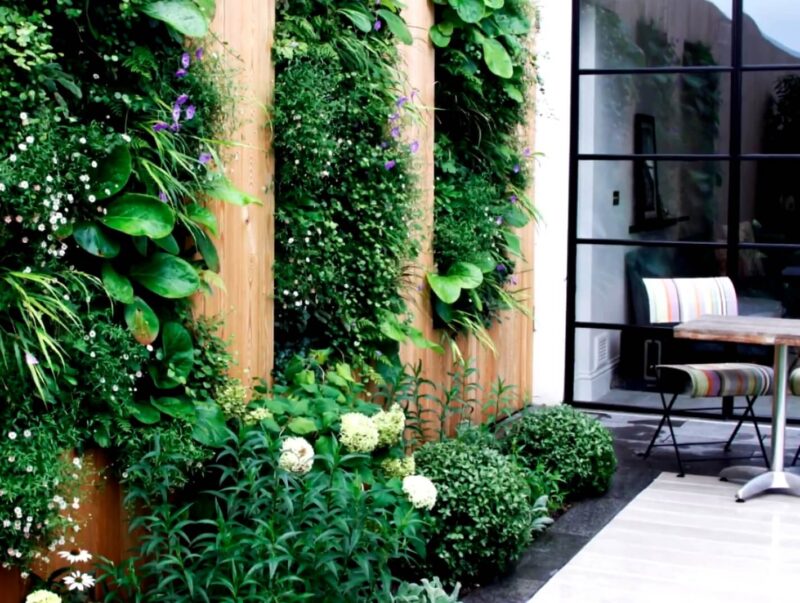
Creating a living wall can transform your balcony or patio into a vibrant, green oasis. This vertical garden not only maximizes space but also enhances air quality and provides a stunning visual element that connects your outdoor area to nature.
A living wall can feature a variety of plants, from herbs and flowers to ferns and succulents, providing both beauty and functionality.
Benefits of a Living Wall
- Space Efficiency: Perfect for small balconies or patios, living walls utilize vertical space to accommodate more plants without requiring a larger footprint.
- Improved Air Quality: Plants absorb carbon dioxide and release oxygen, contributing to a healthier environment.
- Thermal Regulation: Green walls can help moderate temperatures, making your outdoor space more comfortable in both summer and winter.
- Noise Reduction: The foliage can act as a sound barrier, creating a more peaceful environment.
Practical Steps for Installation
- Choose the Right Structure: Select a sturdy frame or modular system designed for living walls. Options include pre-planted panels or DIY setups using pocket planters or vertical garden kits.
- Select Suitable Plants: Opt for plants that thrive in your local climate and suit your light conditions. Some ideal choices include:
- Herbs: Basil, mint, and rosemary for culinary use.
- Foliage Plants: Ferns and ivy for a lush appearance.
- Flowering Plants: Petunias or nasturtiums for vibrant colors.
- Install a Drip Irrigation System: Ensure plants receive adequate moisture by incorporating a drip irrigation system. This will reduce maintenance while keeping plants healthy.
- Position Your Living Wall: Place it where it receives the right amount of sunlight based on your chosen plants. Consider a location that allows you to enjoy the view from your seating area.
Additional Suggestions
- Vertical Planters: Use stackable pots or wall-mounted planters for easy installation and maintenance.
- Mix Plant Sizes: Incorporate plants of varying heights to create visual interest and depth.
- Regular Maintenance: Schedule periodic watering, pruning, and fertilizing to keep your living wall healthy and thriving.
Also, consider purchasing pre-planted living wall kits from local garden centers or online retailers. Brands like Woolly Pocket offer a variety of options suitable for both indoor and outdoor use.
2. Fill Each Room with Flowers
Incorporating flowers into your balcony or patio design adds color, fragrance, and a lively atmosphere. Strategically placing flowers throughout your outdoor space enhances the overall aesthetic and creates a more inviting environment.
Benefits of Using Flowers
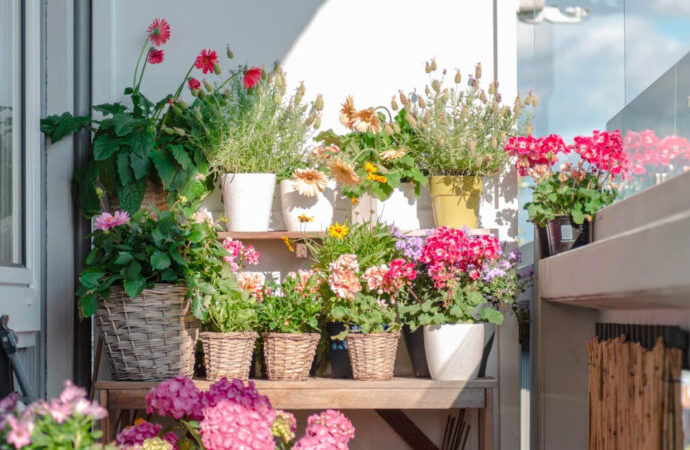
- Visual Appeal: Flowers add vibrant colors and diverse shapes that enhance the beauty of your outdoor area.
- Fragrance: Many flowers emit pleasant scents, creating an inviting atmosphere that stimulates the senses.
- Connection to Nature: Flower-filled spaces foster a strong connection to nature, promoting relaxation and well-being.
Practical Tips for Flower Arrangement
- Choose Varieties for Continuous Bloom: Select flowers that bloom at different times throughout the season to ensure color year-round. Consider:
- Annuals: Petunias, marigolds, and zinnias for vibrant summer blooms.
- Perennials: Lavender and daisies for returning beauty each year.
- Seasonal Options: Use seasonal flowers like chrysanthemums in the fall or pansies in the spring.
- Group Flowers by Color: Create harmonious arrangements by grouping flowers with complementary colors. For example, pair yellow marigolds with purple petunias for a striking contrast.
- Use Varying Heights: Incorporate flowers of different heights for a layered effect. Taller plants can anchor corners, while shorter varieties can fill in gaps.
- Choose Containers Wisely: Use pots and containers that complement your outdoor décor. Terracotta pots offer a rustic touch, while ceramic or metal containers can provide a modern flair.
Additional Suggestions
- Window Boxes: Install window boxes filled with flowers to enhance curb appeal and extend your floral display beyond your patio or balcony.
- Hanging Planters: Utilize hanging planters for trailing flowers like lobelia or petunias. This adds a cascading effect that draws the eye upward and creates visual interest.
- Seasonal Arrangements: Change out flower arrangements seasonally to keep your outdoor space feeling fresh and inviting.
3. Draw the Outside In
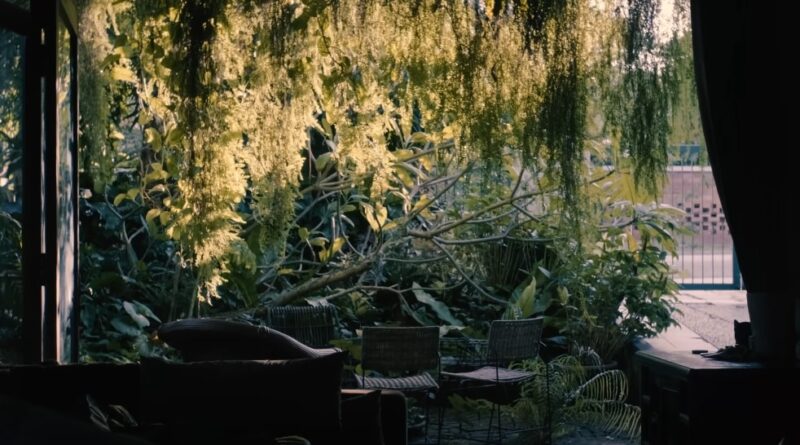
Transform a balcony or patio into a true extension of nature. Focus on creating an inviting space that feels connected to the natural world. Simple changes turn ordinary areas into refreshing retreats, making them perfect for relaxation.
Open Up the Space
Use lightweight, foldable furniture for easy arrangement. Clear out clutter to allow air and light to flow better. Position seating to face appealing views, like a city skyline or your lush garden.
Add Greenery for Life
Even small areas benefit from well-chosen greenery. Hang planters vertically to save space, with ferns or ivy cascading down. Use a mix of plant sizes: tall potted trees in corners, medium plants on the ground, and small herbs on shelves.
Use Natural Elements
Place a bamboo screen for privacy and a natural feel. Soft jute rugs add texture underfoot. These elements make the area warm and organic.
Choose Earthy Colors
Scatter cushions in matching tones and place terracotta pots for added warmth. Small accents tie the look together while keeping the space harmonious.
4. Nature-Inspired Interior
Turn your balcony or patio into a natural haven. Use elements inspired by nature to create a welcoming, peaceful atmosphere that feels timeless and connected to the outdoors.
- Mix natural textures: Combine materials like clay pots, wicker chairs, and stone tabletops to bring depth.
- Add soft furnishings: Use cushions or throws with floral or leaf prints for a nature-inspired touch.
- Keep it raw: Choose unfinished wood or stone pieces for a more organic, rustic appeal.
- Decorate with natural art: Hang botanical prints or display landscape photographs to remind you of the outdoors.
Personalize Your Space
- Add sentimental elements: Incorporate driftwood, collected stones, or shells from past adventures to give a unique, personal vibe.
- Pick hardy plants: Opt for low-maintenance greenery like succulents or air plants if you lack a green thumb.
5. Natural Materials and Elements
Elevate your balcony or patio with elements straight from nature. Using organic materials not only enhances the space but also promotes a sense of calm and balance.
Compact Suggestions for a Natural Upgrade
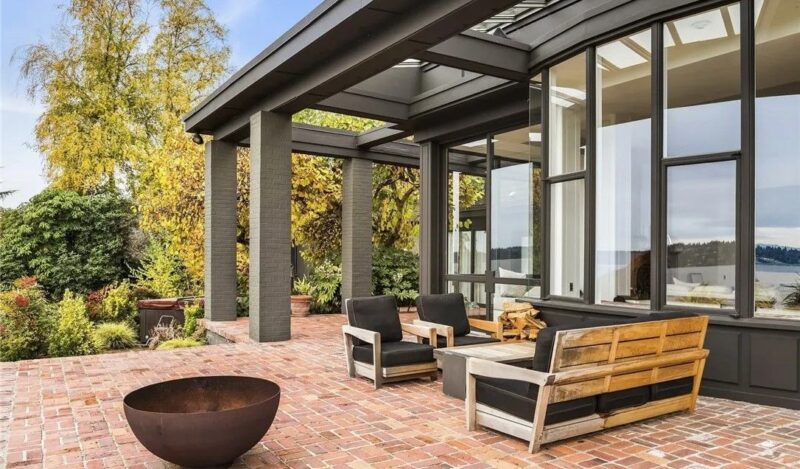
- Wood accents: Choose untreated wood furniture or decking for a raw, earthy feel. Teak and cedar work well outdoors due to their durability.
- Stone decor: Add a stone bench or use pebble-filled planters to ground the space with a natural texture.
- Woven elements: Bring in rattan chairs or jute rugs to create a warm, inviting look that complements greenery.
- Clay and terracotta: Use terracotta pots for plants or clay lanterns to add warmth and an organic touch.
Practical Ideas
- Combine textures: Mix wood, stone, and woven pieces to create depth and a cohesive outdoor sanctuary.
- Layer for comfort: Add soft, cotton seat cushions to your wooden benches for a cozy spot to relax.
Also, you can always explore to check out what others are doing to get some fresh and unique ideas on creative ways to add biophilic design to your home. As you can see, the proper combination of different elements is crucial. Those who are looking for recommendations and tips from experts can find inspiration here.
Additional Suggestions
- Wooden furniture: Choose untreated or reclaimed wood for tables and chairs. This adds warmth and an organic touch, making the space feel inviting.
- Stone accents: Incorporate natural stone elements, such as a gravel pathway or a stone bench, to provide a grounding effect and connect with the earth.
- Woven textures: Use materials like rattan or wicker for seating and decor. These bring in natural patterns and textures that enhance the overall ambiance.
6. Ensure More Light in the Room
Maximize natural light on your balcony or patio to create a bright and uplifting space. Sunlight not only enhances the look but also boosts mood and well-being.
Practical Tips to Bring in More Light
- Clear obstructions: Remove anything blocking sunlight, like heavy planters or bulky furniture.
- Use sheer curtains: Replace heavy drapes with light, sheer options to keep the space airy.
- Reflective surfaces: Position mirrors strategically to bounce light around and make the area feel more spacious.
- Glass furniture: Opt for glass tables or accents that keep the space open and let light travel freely.
Easy Suggestions for Maximum Impact
- Bright accents: Use light-colored cushions and decor to amplify the natural light in your space.
- Open up: Consider installing glass doors or large windows if possible, to blur the boundary between indoor and outdoor spaces.
7. Get More Fresh Air with Plants
Bringing fresh air into your balcony or patio is essential for biophilic design. It creates a lively, breathable space filled with greenery that allows you to fully enjoy the outdoors.
Smart Ways to Bring in Fresh Air with Plants
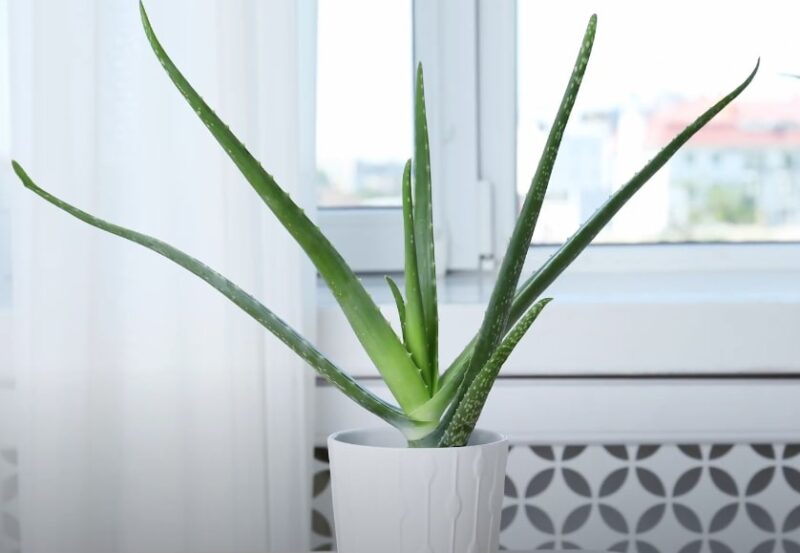
- Maximize airflow: Keep doors and windows open to let the breeze flow through your space, enhancing the natural atmosphere.
- Incorporate air-purifying plants: Use greenery like peace lilies, snake plants, or spider plants. These plants improve air quality while adding life and color to your outdoor area.
- Create a green barrier: Install bamboo or slatted screens with climbing plants like jasmine or ivy. This provides privacy while allowing fresh air to circulate.
Enhance Your Space with Additional Greenery
- Herb gardens: Grow aromatic herbs like mint, basil, or lavender in pots. These not only freshen the air but also provide culinary delights.
- Layer plant heights: Use a mix of tall potted plants, medium-sized greenery, and small herbs to create depth and interest, ensuring the space feels lush and inviting.
8. Choose a Calming Color Palette
Colors inspired by nature help make the space inviting and soothing.
Effective Color Choices for Outdoor Spaces
- Earthy tones: Use shades of brown, green, and beige to reflect the natural landscape. These colors provide a warm, grounded feel.
- Soft blues: Light blue and sky tones create a sense of calm and openness, reminiscent of the sky and water.
- Accent colors: Incorporate bright colors through cushions or decorative elements in floral hues, such as soft pinks or sunny yellows, to add life and vibrancy.
Tips for a Cohesive Look
- Balance neutrals with color: Use neutral colors for larger furniture pieces and add colorful accessories for a lively touch without overwhelming the space.
- Natural patterns: Choose fabrics or decor with patterns that mimic nature, such as leaf motifs or floral designs, to reinforce the connection to the outdoors.
9. Create Cozy Nooks
Designing cozy nooks on your balcony or patio adds comfort and functionality. These spaces serve as perfect spots for relaxation, reading, or enjoying a cup of coffee. Incorporating thoughtful elements can transform your outdoor area into a personal sanctuary.
Ideas for Cozy Nooks
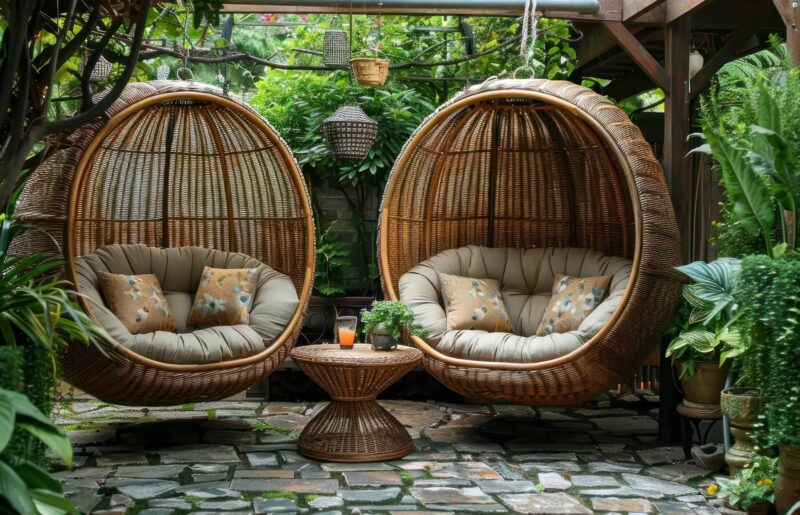
- Choose comfortable seating: Select pieces like a hammock chair, outdoor sofa, or oversized lounge chairs that invite you to relax. Look for weather-resistant materials that can withstand outdoor conditions.
- Layer with cushions and throws: Use a variety of soft cushions in different sizes and textures. Choose outdoor fabrics that are durable and fade-resistant. Add warm, lightweight throws for those cooler evenings.
- Incorporate a small table: A side table or a coffee table provides a convenient spot for drinks, books, or snacks. Consider materials like reclaimed wood or metal for a rustic touch that fits with the natural theme.
Practical Suggestions
- Create shade: Use umbrellas, awnings, or pergolas to provide shade, making your nook enjoyable even on sunny days. A retractable awning allows for flexibility, providing sun protection when needed and opening up for more light when desired.
- Include plants for privacy: Surround your cozy nook with tall plants, such as bamboo or ornamental grasses, to create a natural privacy barrier. Alternatively, use a trellis with climbing vines like jasmine or morning glories for a green wall effect.
- Install outdoor lighting: String lights or lanterns create a warm ambiance, making the space usable after sunset. Look for solar-powered options for an eco-friendly choice that requires minimal maintenance.
- Add a rug: Use a weather-resistant outdoor rug to define the space and add comfort underfoot. Choose a pattern or color that complements your decor, adding warmth and coziness.
- Personal touches: Incorporate personal items like favorite books, magazines, or decorative pieces that reflect your style. A small shelf or basket can hold these items within easy reach.
10. Use Biomorphic Forms and Patterns
Incorporating biomorphic forms and patterns into your balcony or patio design adds a natural touch and enhances the overall aesthetic.
Ideas for Using Biomorphic Forms
- Curved Furniture: Opt for furniture with soft, rounded edges instead of sharp lines. Look for chairs and tables that mimic natural shapes, like a pebble or leaf.
- Organic Patterns: Use textiles, cushions, or rugs that feature floral or leaf motifs. These patterns bring the essence of nature into your space.
- Artistic Decor: Include sculptures or decor items that resemble natural forms, such as abstract representations of plants or animals, to create a cohesive theme.
Practical Tips
- Balance Biomorphic Shapes: Pair curved furniture with straight lines to avoid overwhelming the space. This balance creates visual interest without chaos.
- Choose Earthy Colors: Use colors that reflect natural elements, such as greens, browns, and soft blues, to complement the biomorphic forms and patterns.
11. Pottery and Natural Decor Elements
Incorporating pottery and other natural decor elements into your balcony or patio adds character and warmth. These items enhance the biophilic design and create a more inviting atmosphere.
Ideas for Using Pottery and Decor
- Variety of Pots: Use different styles and sizes of pots to display plants. Choose terracotta for a rustic look or ceramic for a more polished appearance.
- Decorative Bowls: Use shallow bowls filled with stones, sand, or succulents as centerpieces on tables or shelves.
- Natural Accents: Add decor items made from materials like wood, stone, or bamboo to enhance the natural feel of the space.
Practical Tips
- Mix Textures: Combine smooth pottery with rougher materials like stone or wood for a visually appealing contrast.
- Seasonal Decor: Change out decor elements according to the seasons, using autumn leaves or holiday-themed items to keep the space fresh.
12. Include Porches and Enclosed Patios
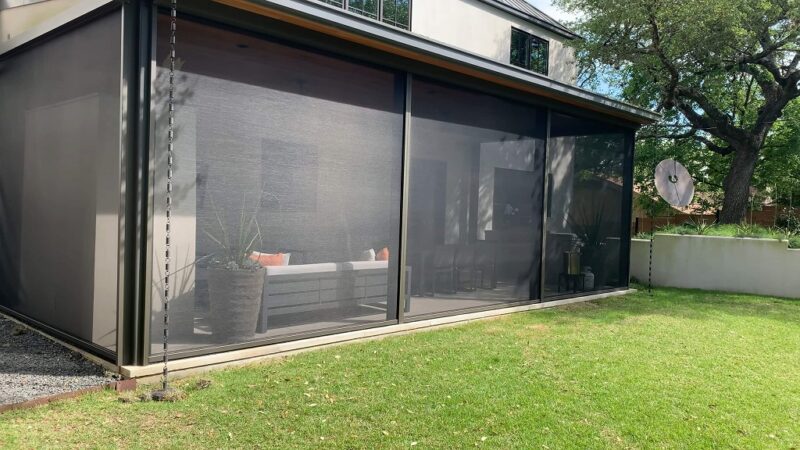
Adding porches or enclosed patios to your home expands your living space and strengthens your connection to the outdoors.
Benefits of Porches and Enclosed Patios
- Extended Living Space: Porches and patios create additional areas for lounging, dining, or entertaining, making your home feel larger.
- Protection from the Elements: Enclosed spaces allow you to enjoy the outdoors while being shielded from rain, wind, or intense sun.
Practical Suggestions
- Design for Versatility: Furnish these spaces with comfortable seating and flexible tables that can accommodate different activities, from casual gatherings to family dinners.
- Use Large Windows or Screens: Install large windows or screens to maintain airflow and natural light while keeping pests out.
13. Faux Plants for Low Maintenance
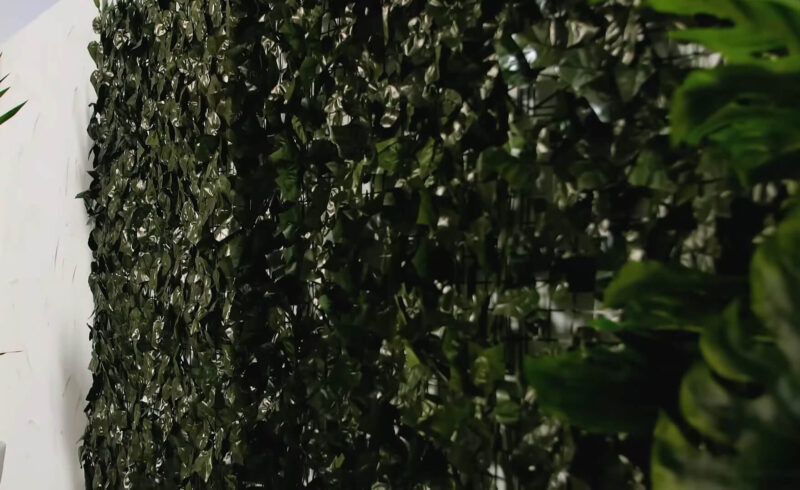
Using faux plants in your balcony or patio design offers the beauty of greenery without the upkeep. This option is ideal for those who want to enjoy a vibrant space without the commitment of live plants.
Benefits of Faux Plants
- No Maintenance Required: Unlike real plants, faux varieties do not need watering, pruning, or specific lighting conditions.
- Durability: High-quality faux plants can withstand outdoor conditions without fading or wilting.
Practical Suggestions
- Choose Realistic Designs: Invest in high-quality faux plants that closely mimic the appearance of real ones. Look for details like varied leaf shapes and natural colors.
- Mix Faux with Real Plants: Combine faux plants with live ones to create a fuller, more dynamic look. This approach allows for visual diversity while minimizing maintenance.
FAQs
What are the best types of plants for small balconies or patios?
When selecting plants for small spaces, opt for compact varieties. Herbs like basil and mint are great choices, as they do not take up much space and can be used in cooking. Other options include succulents, dwarf varieties of ornamental grasses, and small flowering plants such as pansies or petunias.
How can I add privacy to my balcony or patio without sacrificing light?
To create privacy while allowing light to filter through, consider using sheer curtains or lattice screens adorned with climbing plants. Tall potted plants or trellises can also provide privacy without blocking sunlight. Additionally, strategically placing furniture can help create a sense of enclosure without feeling cramped.
What outdoor furniture is best for a biophilic design?
Choose outdoor furniture made from natural materials like wood, wicker, or bamboo. Look for pieces with organic shapes and soft lines that harmonize with the natural environment. Weather-resistant cushions in earthy tones or nature-inspired patterns can enhance comfort and style.
How can I maintain a clean and tidy outdoor space?
Regular maintenance involves cleaning surfaces to remove dirt and debris. Use storage solutions like benches with hidden compartments or stylish baskets for items like cushions or garden tools. Create a routine for pruning plants and watering to prevent overgrowth and clutter.
What lighting options enhance a biophilic outdoor space?
Consider using soft, ambient lighting such as string lights or solar-powered lanterns to create a warm atmosphere. Incorporate fixtures that mimic natural forms, like lanterns shaped like flowers or leaves. Avoid harsh lighting to maintain a serene and inviting environment.
Last Words
The beauty of biophilic design lies in its versatility. Whether your outdoor space is expansive or compact, there are countless ways to infuse nature into your surroundings. Consider personalizing your area with sentimental decor and practical elements that reflect your style. Regular maintenance ensures that your oasis remains lush and inviting year-round.

